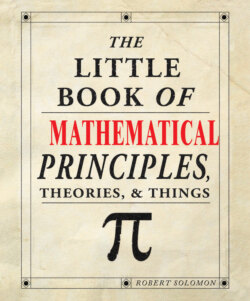Читать книгу The Little Book of Mathematical Principles, Theories & Things - Robert Solomon - Страница 8
На сайте Литреса книга снята с продажи.
3rd millennium BC Egypt & Babylonia Fractions
ОглавлениеThere are different systems for writing fractions. This has always been the case, even in ancient times. For example, the Egyptian system was very limited, while the Babylonian system is still in use today.
_______________
Any advanced civilization has a system of writing fractions. Despite their renowned technological prowess, the Ancient Egyptians had a system of fractions that was comparatively clumsy.
With the exception of 2/3, the only fractions recognized by the Ancient Egyptians were those with 1 on the top, called aliquot fractions, such as 1/2, 1/3, 1/4. Any other fraction had to be written in terms of these aliquot fractions. Furthermore, they were not allowed to repeat a fraction. If they wanted to write 2/5, for example, they could not write it as 1/5 + 1/5. For the second 1/5, they had to find aliquot fractions with sum 1/5, such as 1/6 + 1/30. So they wrote 2/5 as 2/5 = 1/5 + 1/6 + 1/30 (and there are other possibilities too).
Few examples of Ancient Egyptian mathematics survive, although one that does is a leather scroll, dated from about 1650 BC, which contains fractional calculations such as the one earlier.
The Babylonian system was more flexible, following their system of writing whole numbers. Each unit is divided into 60 smaller parts, called minute parts, then each minute is divided into 60 parts, called second minute parts, and this continues with third minute parts and fourth minute parts. This system is still used today for telling the time. We divide an hour into 60 minutes and a minute into 60 seconds. (Seconds are divided into decimal fractions rather than thirds and fourths, however.)
Why was 60 chosen both for whole numbers and for fractions? Most probably because it has so many divisors and, consequently, many fractions terminate.
Consider the fractions 1/2, 1/3, 1/4 up to 1/9. Using ordinary decimals, four of them, 1/2, 1/4, 1/5, and 1/8, have a terminating representation. The other four, 1/3, 1/6, 1/7, and 1/9, have a recurring representation, such as 1/3 = 0.3333… (the threes go on ad infinitum). Using Babylonian fractions, only 1/7 does not have a terminating representation.
Nowadays, we have two ways of writing fractions. When 5 is divided by 8, the result can be written either as 5/8 or as 0.625.
See: Writing Numbers, page 8
